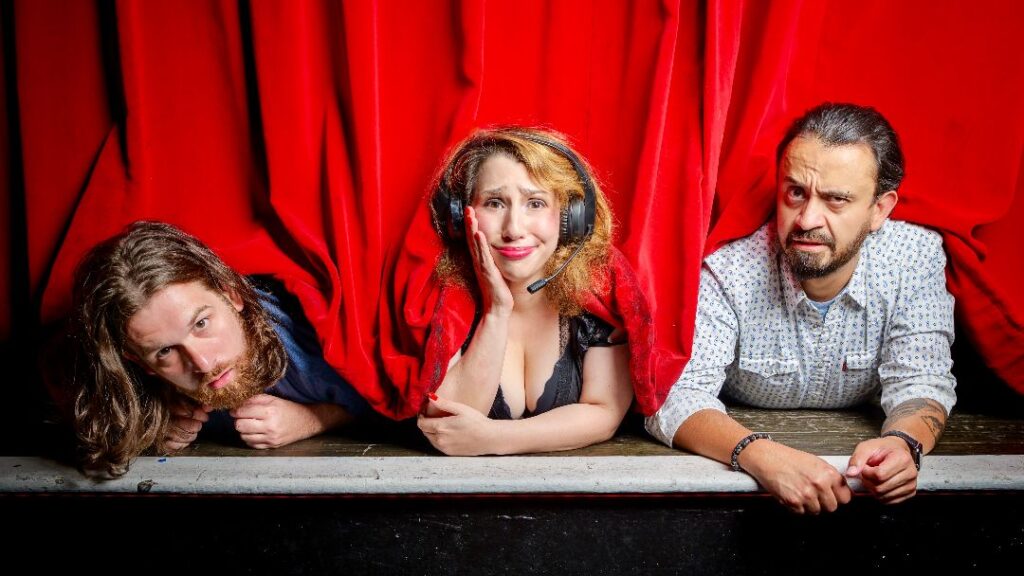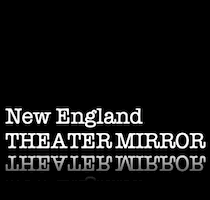
‘The Understudy’ — Written by Theresa Rebeck. Directed by Paula Plum. Scenic Design by Peyton Tavares. Projections Design by Justin Lahue. Sound Design by Gage Baker. Lighting Design by Emily Bearce. Costume Design by Kara McGuinness. Presented by Hub Theatre Company of Boston at Club Café, 209 Columbus Ave., Boston, through August 2.
By Charlotte Snow
There is no harder play to write than one with three persons. It’s tough to balance roles, hard to envision blocking properly, and there’s a reason the adage of ‘three is a crowd’ exists. However, when a script manages to juggle three-person scenes properly, they end up being some of the best in the theatrical canon (think Glass Menagerie, Red Light Winter, This is Our Youth, Proof, Agnes of God, The Flick, Angels in America, the list goes on). Do I believe Theresa Rebeck’s ‘The Understudy’ deserves to join that list? Not quite. However, the Hub Theatre Company must be commended for the incredible effort in making the case.
‘The Understudy’ is a 2010 comedy written by beloved American playwright Theresa Rebeck, best known for ‘Bernhardt/Hamlet’ and the Steven Spielberg-produced TV show ‘Smash.’ The story follows a starving artist/actor, Harry (Kevin Paquette), who is at a put-in rehearsal (where an understudy or replacement rehearses their role with the cast). He is the understudy of C-list actor, Jake (Cristhian Mancinas-García), and holds a resentment against him for starring in the latest blockbuster, Trucknado. Overseeing their feud and the in-shambles rehearsal is the world-weary and overworked stage manager, Roxanne (Lauren Elias), who once had a relationship with Harry. From there, hijinks ensue as the three begin to bond, finding their similarities between their spats and the play’s metatheatrical bits.
Kevin Paquette, Cristhian Mancinas-García, and Lauren Elias expertly share the stage and bounce off each other. Their chemistry keeps the rhythm of the play going and brings a lot of honesty and pathos to characters who could, at times, be caricature-ish and unlikable. Even when the play drags, they commit to the truths of their characters and forge onward. Paula Plum’s direction and composition of scenes is as deft as it is consistent, allowing the actors to flourish.
A fair warning about ‘The Understudy’ is that the comedy is so ‘inside baseball’ to the theatre industry that I half expected Jackie Robinson to appear and have an opinion on interior decoration. So if jokes about the theater and its culture work for you, you’ll be laughing out loud throughout. For me, the humor was hit and miss, as I found the situational relationship-based jokes the most surprising and witty. There was also a love triangle introduced about halfway into the play that didn’t go anywhere and felt included solely to pad the runtime. Where the script really shined – humor and forced romance aside – was in its more poignant moments. A throughline for all these characters was their often-oppositional relationships to theatre as a profession. The struggle of getting work that is both creatively and financially fulfilling is a struggle that all creatives know far too well. Not to mention that one often comes at the expense of the other. The moments when these three are confronted with those harsh truths are when the play is at its strongest and gets to be a criticism as well as a love letter to theatre.
A fun quirk of this production is that the venue is the back room of Club Café, a gay bar, which is a plus in my eyes. That said, it is an added difficulty for the audience to suspend their disbelief enough to believe that it’s an upscale New York theatre. Set design by Peyton Tavares, which consists of three flats on wheels decked with candelabras, aids in this effort. The same can be said for the projections, designed by Justin Lahue, ranging from videos to GIF-like slides that help fill out the world of the play. These contributions are especially appreciated, considering there is a giant disco ball affixed to the ceiling above the audience’s heads. The sound and light design, by Gage Baker and Emily Bearce, respectively, add many moments of levity.
Hub Theatre Company is a pay-what-you-can theatre company, actively making Boston theatre accessible. While I do believe that this model of company ought to be celebrated and taken advantage of whenever possible, I’m recommending this play solely on its merits. It’s not always the deepest, and your mileage may vary regarding the style of humor. However, there are many moments that hit hard and are supported by three highly spirited actors.
For more information and tickets, visit: http://www.hubtheatreboston.org/

